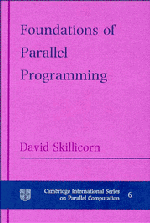Book contents
- Frontmatter
- Contents
- List of Figures
- Preface
- 1 The Key Idea
- 2 Approaches to Parallel Software Development
- 3 Architectural Background
- 4 Models and Their Properties
- 5 The Categorical Data Type of Lists
- 6 Software Development Using Lists
- 7 Other Operations on Lists
- 8 A Cost Calculus for Lists
- 9 Building Categorical Data Types
- 10 Lists, Bags, and Finite Sets
- 11 Trees
- 12 Arrays
- 13 Graphs
- 14 Conclusions
- A C++ Library for Lists
- B Historical Background
- References
- Index
4 - Models and Their Properties
Published online by Cambridge University Press: 25 October 2009
- Frontmatter
- Contents
- List of Figures
- Preface
- 1 The Key Idea
- 2 Approaches to Parallel Software Development
- 3 Architectural Background
- 4 Models and Their Properties
- 5 The Categorical Data Type of Lists
- 6 Software Development Using Lists
- 7 Other Operations on Lists
- 8 A Cost Calculus for Lists
- 9 Building Categorical Data Types
- 10 Lists, Bags, and Finite Sets
- 11 Trees
- 12 Arrays
- 13 Graphs
- 14 Conclusions
- A C++ Library for Lists
- B Historical Background
- References
- Index
Summary
In Chapter 2 we listed some of the requirements that a model for general-purpose parallel computation should satisfy: architecture independence, intellectual abstractness, having a software development methodology, having cost measures, having no preferred scale of granularity, and being efficiently implementable. In Chapter 3, we saw how results about emulation of arbitrary computations on architectures mean that efficient implementability can only be achieved by restricting the communication allowed in computations. In this chapter, we examine existing models and parallel programming languages and see how they measure up to these requirements.
Many of these models were not developed with such an ambitious set of requirements in mind, so it is not a criticism of them if they fail to meet some. Nevertheless, it provides a picture of the current situation. The absence of a popular or standard model, even in particular application domains, and the wide range of models that have been proposed, underline some of the difficulties of using parallelism in a general-purpose way that were discussed in Chapter 2. It is not possible to cover all proposed models for parallel computation, but a representative selection has been included.
There are several other good surveys of programming models from different perspectives. Crooks and Perrott [59] survey models for distributed-memory architectures, particularly those that provide abstractions for data partitioning and distribution. Turcotte [195] surveys models suitable for networks of workstations. Bal et al. [20] survey architecture-specific models.
The distinctions between models and programming languages are not easy to make.
Information
- Type
- Chapter
- Information
- Foundations of Parallel Programming , pp. 27 - 48Publisher: Cambridge University PressPrint publication year: 1994
